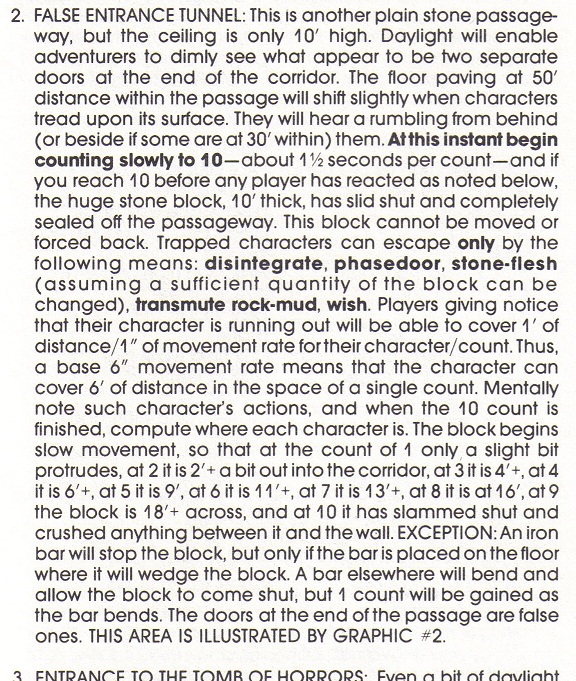Umbran said:
Typical module design of the time didn't actually expect folks to engage in mining activities - if it was designed so a trap closed off one route, then another route usually existed.
Not to contradict you on this point, but the first thing to came to my mind upon reading this is the blocked corridor in the Caves of Chaos -- it specifically explains the effort necessary to clear and move beyond the blockage.

* * *
Stoat said:
What does it take to survive the ToH? Does the module provide enough clues to allow the players to navigate the Tomb safely? How much guesswork, dumb luck or divination magic is necessary to get through the Tomb? How much can be accomplished with caution and reason alone?
I'm going to throw out some information for your discussion. I'm not making judgment on these items; I'm just putting out the information for consideration. And since you are reading the adventure text, you can check what I say directly as you come to the relevant info.
The adventure seems to sometimes support persistence, and sometimes it punishes.
For instance:
The clue in the entrance path. Only if a Player has been examining the path all the way from the beginning to the end will they notice the long poem clue. Persistence to examining the path pays off with information about the Tomb.
Part of the clue mentions the color green is bad but black ("night's good color"?) is good.
Right in front of this mention is the black sphere of annihilation. The demon-face mount for the sphere is green.
Now, the clue in the path is actually referring to the next corridor over, which the Players have not yet found and don't know exists. It is easy for the Players to think the clue is referring to what is right before them. I've read instances of whole parties jumping into the sphere (not knowing what it truly is).
Later, the 3-armed gargoyle statue: The hands have depressions fit for 100gp gems. (What does a 100gp gem look like? Are they all the same?) If you put a gem in each hand of the statue, the hand will crush the gem and dump the powder to the floor. Now, some Players would think, "OK, I don't want to do that again." But here, persistence (destroying multiple valuable gems) will pay off. When the 10th gem is destroyed, (probably along with the 11th and 12th at the same time), a gem of true seeing will materialize. (But it's invisible and may actually be completely undiscovered.) So persistence against something that would be very stupid outside the Tomb gets rewarded. (The Players have no way of knowing anything will come of destroying 1,000 gp worth of gems -- as far as they know, the crushing might never stop -- why keep "feeding" gems to the statue?)
Later, the ring slot: There's a slot for inserting a magic ring that will open a secret door. Supposedly the slot looks right for inserting a magic ring, but what does a magic ring look like, and are they all the same? And how would the PCs know that the ring wouldn't be destroyed, (like the gems earlier)?
Later, there is a secret door hidden in a spiked-pit trap: The only way to find this secret door is to search down inside the pit trap. If a party has been flying to avoid floor traps, they'd never find this door and would not be able to advance further into the Tomb. (They'd probably head on to the TPK trap down the hall.)
Later, there is a door with slots for swords: The slots apparently look sized for swords to fit into. (Again, do all swords look alike?) Even if the Players figure out that they are to insert their (probably magical) swords into the slots, how do they know their items won't be destroyed (like the gems earlier)?
These examples, and others, are reasons why I think ToH is not the logical and reasonable trap maze that some say it is. In one place, an action is punished/rewarded, and then in another place, a similar action is rewarded/punished.
And the clues that some say are readily available in the path into the Tomb is only at the entrance of the place, and requires the Players to examine something closely for well past the duration that most Players would bother. (The DM is directly told that only if the Player has examined the path all the way from the door to the end of the hall, will they discover the message hidden there in.)
Also keep in mind that ToH was published at a time when the rules prevented repeat tries on many things -- you could only roll a search check once for a secret door or a trap. So many players would be used to accepting, "You don't find anything," from the DM as the one and only shot they had. Many would not think they could just continue searching beyond the first failure.
There are many things in the ToH that break the very pattern it seems to be trying to test.
"Be paranoiaingly cautious, but try many things."
"Don't make the same mistake twice, but keep trying things that go bad."
"Everything you do can kill you, including doing nothing, so do everything including nothing."
Whether this is good or bad, I guess, depends on the DM and Players.
Bullgrit


